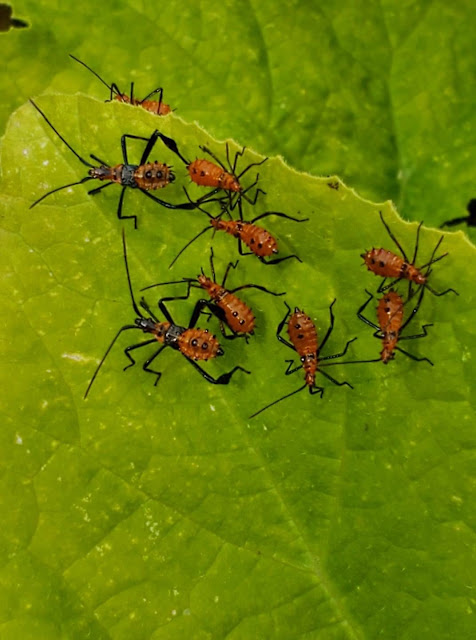
What's eating my (whatever)? Be curious, be aware, and you'll find out

|
|
These are leaf-footed bug nymphs. The ones I found and
quickly dispatched this morning looked exactly like this. They
are smaller than you might expect.
|
Gardeners, the invasion is upon us. It's time to take up arms -- and open our eyes -- and learn to outwit the interlopers, or at least slow them down.
The insect pests and vertebrate pests are eyeing and trying our new vegetables, our developing fruit, our flower buds. Easy pickings for them, if we're not vigilant. Example: I knocked a collection of leaf-footed bug nymphs into a cup of soapy water this morning. They were hanging out on my little Babycakes blackberry bush. Do I think I got them all? No way -- now I'll be looking for them everywhere, every day.
Train yourself to figure out what's going on. Relying on answers from social media is a gamble -- and the answers too often are guesses. Be certain of the source of the information. The best source I know is the UC Integrated Pest Management Program and it's right there on your phone, just like social media. The IPM Plant Problem Diagnostic Tool is invaluable.
Oh, and can I say this: Neem Oil Is Not the Answer to Every Garden Problem!
Now, a few words on being a garden detective: Use your eyes! Get a magnifying glass if necessary. Get out into the garden often, at different times of day. Then consider these questions, and you might be able to answer that "what's eating" question yourself.
-- Are the leaves full of holes? Look where the holes are; different pests leave different clues. On leafy green vegetables, for instance, caterpillars tend to sit on the ribs of leaves and chew out the leaf tissue in between. Holes along the leaf edges of a new transplant could be from birds.
-- Are leaves or fruit becoming stippled? There's likely a piercing-sucking insect pest on the loose. Could be thrips or leafhoppers or a number of others. If you also see fine webbing, the pest very likely is spider mites.
-- Are there small loose black dots on leaves? That's likely poop from caterpillars or worms. Examine the leaves above it to find the culprit.
For insect management, this IPM page is the place to start . Be sure to look at the photos of insect nymphs (juveniles), too. They often look very different from their adult versions.
-- Are there bite marks in the almost-ripe tomatoes? Rats, voles, raccoons and squirrels are most likely the biters. Birds will peck at fruits, though enough pecks can look like bites. Deer will take the whole fruit or flower and much of the plant if they can. Here's the IPM link to vertebrate pests . (Tomato hornworms will attack tomato fruit, too, but they'll eat the unripe green ones, along with the plant's leaves.)
-- Is the plant dead/dying all of a sudden? Don't blame insects. To quote the California Master Gardener Handbook: "With a few exceptions, insects and mites seldom kill their host plants, but diseases often do." And that's a topic for another day!
Still have questions about your plants? Ask the UCCE master gardeners! The Sacramento County office is at 4145 Branch Center Road, Sacramento, and the phone number is (916) 876-5338. Or email mgsacramento@ucanr.edu.
Comments
0 comments have been posted.Sacramento Digs Gardening to your inbox.
Sites We Like
Garden Checklist for week of April 14
It's still not warm enough to transplant tomatoes directly in the ground, but we’re getting there.
* April is the last chance to plant citrus trees such as dwarf orange, lemon and kumquat. These trees also look good in landscaping and provide fresh fruit in winter.
* Smell orange blossoms? Feed citrus trees with a low dose of balanced fertilizer (such as 10-10-10) during bloom to help set fruit. Keep an eye out for ants.
* Apply slow-release fertilizer to the lawn.
* Thoroughly clean debris from the bottom of outdoor ponds or fountains.
* Spring brings a flush of rapid growth, and that means your garden needs nutrients. Fertilize shrubs and trees with a slow-release fertilizer. Or mulch with a 1-inch layer of compost.
* Azaleas and camellias looking a little yellow? If leaves are turning yellow between the veins, give them a boost with chelated iron.
* Trim dead flowers but not leaves from spring-flowering bulbs such as daffodils and tulips. Those leaves gather energy to create next year's flowers. Also, give the bulbs a fertilizer boost after bloom.
* Pinch chrysanthemums back to 12 inches for fall flowers. Cut old stems to the ground.
* Mulch around plants to conserve moisture and control weeds.
* From seed, plant beans, beets, cantaloupes, carrots, corn, cucumbers, melons, radishes and squash.
* Plant onion sets.
* In the flower garden, plant seeds for asters, cosmos, celosia, marigolds, salvia, sunflowers and zinnias.
* Transplant petunias, zinnias, geraniums and other summer bloomers.
* Plant perennials and dahlia tubers for summer bloom.
* Mid to late April is about the last chance to plant summer bulbs, such as gladiolus and tuberous begonias.
* Transplant lettuce seedlings. Choose varieties that mature quickly such as loose leaf.